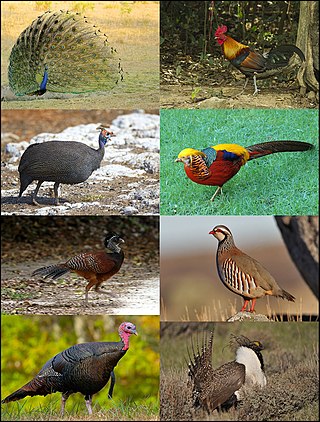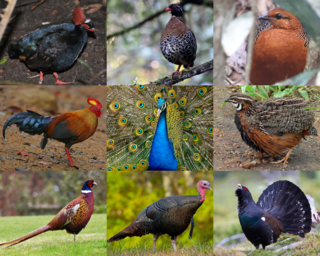
Galliformes is an order of heavy-bodied ground-feeding birds that includes turkeys, chickens, quail, and other landfowl. Gallinaceous birds, as they are called, are important in their ecosystems as seed dispersers and predators, and are often reared by humans for their meat and eggs, or hunted as game birds.

The Anatidae are the biological family of water birds that includes ducks, geese, and swans. The family has a cosmopolitan distribution, occurring on all the world's continents except Antarctica. These birds are adapted for swimming, floating on the water surface, and in some cases diving in at least shallow water. The family contains around 174 species in 43 genera.

The Phasianidae are a family of heavy, ground-living birds, which includes pheasants, partridges, junglefowl, chickens, turkeys, Old World quail, and peafowl. The family includes many of the most popular gamebirds. The family is a large one and includes 185 species divided into 54 genera. It was formerly broken up into two subfamilies, the Phasianinae and the Perdicinae. However, this treatment is now known to be paraphyletic and polyphyletic, respectively, and more recent evidence supports breaking it up into two subfamilies: Rollulinae and Phasianinae, with the latter containing multiple tribes within two clades. The New World quail (Odontophoridae) and guineafowl (Numididae) were formerly sometimes included in this family, but are now typically placed in families of their own; conversely, grouse and turkeys, formerly often treated as distinct families, are now known to be deeply nested within Phasianidae, so they are now included in the present family.

The grey partridge, also known as the grey-legged partridge, English partridge, Hungarian partridge, or hun, is a gamebird in the pheasant family Phasianidae of the order Galliformes, gallinaceous birds. The scientific name is the Latin for "partridge", and is itself derived from Ancient Greek perdix.

Anas is a genus of dabbling ducks. It includes the pintails, most teals, and the mallard and its close relatives. It formerly included additional species but following the publication of a molecular phylogenetic study in 2009 the genus was split into four separate genera. The genus now contains 31 living species. The name Anas is the Latin for "duck".

Mergellus is a genus of duck. The smew (Mergellus albellus) is the only living species, but an extinct species known as Mergellus mochanovi has also been described from Late Pleistocene deposits in the Yakutia region of Russia.

Game or quarry is any wild animal hunted for animal products, for recreation ("sporting"), or for trophies. The species of animals hunted as game varies in different parts of the world and by different local jurisdictions, though most are terrestrial mammals and birds. Fish caught non-commercially are also referred to as game fish.

Coturnix is a genus of five extant species and five to eight known extinct species of Old World quail.

Perdix is a genus of Galliform gamebirds known collectively as the 'true partridges'. These birds are unrelated to the subtropical species that have been named after the partridge due to similar size and morphology.

Perdicula is a small genus of quail in the family Phasianidae, containing four species that are collectively known as the bush quails.

Porzana is a genus of birds in the crake and rail family, Rallidae. Its scientific name is derived from Venetian terms for small rails. The spotted crake is the type species.

The Petralona Cave a karst formation, is located at 300 m (984 ft) above sea-level on the western foot of Mount Katsika, about 1 km (0.62 mi) east of the village of Petralona, about 35 km (22 mi) south-east of Thessaloniki city on the Chalkidiki peninsula, Greece. The site came to public attention when in 1960 a fossilized archaic human skull was found. The cave had been discovered accidentally only a year earlier (1959) after erosion had left clefts in the rock. "Bejeweled" with impressive stalactite and stalagmite formations and holding an abundance of fossils, the cave soon attracted geologists and paleontologists. After decades of excavations the cave is open to the public and scientific work is documented and presented in an adjacent archaeological museum.

Yevgeny Nikolayevich Kurochkin was a Russian paleornithologist at the Paleontological Institute of the Russian Academy of Sciences. He served as President of the Menzbier Ornithological Society.
Chenoanas is an extinct genus of duck from Eurasia. It is known from three species, C. sansaniensis, C. deserta and C. asiatica. The latter two species were named by Nikita Zelenkov.
Pterocles bosporanus is an extinct species of sandgrouse, described in 2023 from early Pleistocene-aged fossil material found in central Crimea. Potential additional remains are known from Italy. The only confirmed specimen is part of a limb bone, and the species is larger than other members of the genus Pterocles.
Caerulonettion is an extinct genus of anatid birds from the Miocene Epoch of Europe. The genus contains a single species, C. natator, known from various limb and girdle bones. The Caerulonettion fossil material was originally assigned to various other anatid genera before being recognized as a distinct genus.
Chauvireria is an extinct genus of small-sized landfowl, belonging to the family Phasianidae, and closely related to modern partridges, Old World quails and francolins. Two species are known from the genus : C. balcanica, the type species, and C. bulgarica. Both species lived in what is today Western Bulgaria during the Early Pleistocene.
Tologuica is an extinct genus of phasianid bird. The remains of both species belonging to the genus, T. aurorae and T. karhui, were discovered in Middle Miocene rocks of the Ööshin Formation, in Mongolia.















